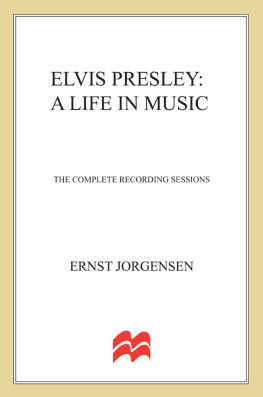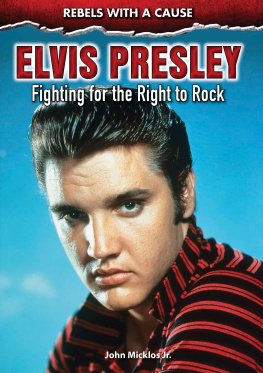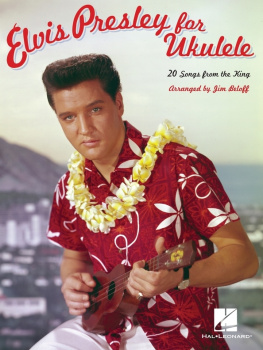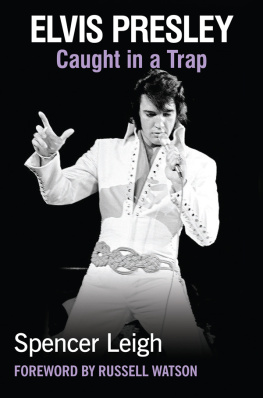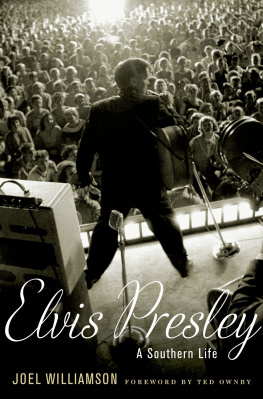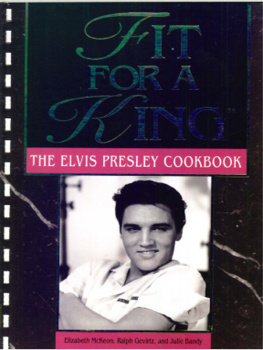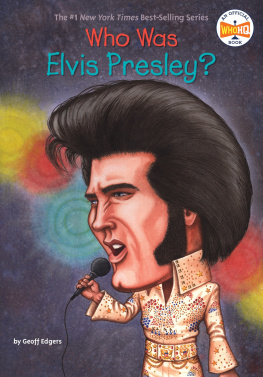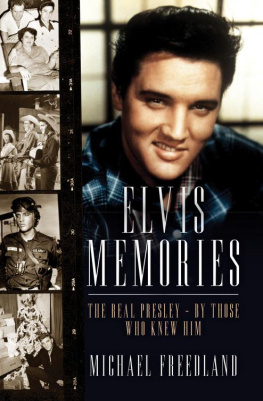Contents
Guide
ELVIS
PRESLEY
A LIFE IN MUSIC
THE COMPLETE
RECORDING
SESSIONS
ERNST JORGENSEN

The author and publisher have provided this e-book to you for your personal use only. You may not make this e-book publicly available in any way. Copyright infringement is against the law. If you believe the copy of this e-book you are reading infringes on the authors copyright, please notify the publisher at: us.macmillanusa.com/piracy.
For Tine and Theodor
ACKNOWLEDGMENTS
Its no understatement to say that this book would not have been possible without the total support of Erik Rasmussen, Alexandra Guralnick, and Peter Guralnick. Should you ever forget how important you were to this project, give me a call and Ill refresh your memories.
Sincere thanks for a great time to St. Martins Presss own Calvert D. Morgan. You made the final editing a truly exciting exercise. Frankly, there was a time when I thought I was the expert. Now Im not so sure!
Thanks also to:
the late Mary and Felton Jarvis;
Carmen Fanzone of the AF of M in Los Angeles, and Harold Bradley and Buddy Harman of the Nashville union, for work beyond the call of duty;
the many employees of RCA Records who helped me over the years: Joan Deary, Rocco Laginestra, Gregg Geller, Ole Jochimsen, Bruce Hailstalk, Bernadette Moore, Steve Sholes, Joyce Triplett, my good friend Chick Crumpacker and his wife, Bunny, and my great colleague, Roger Semon;
the producers, engineers and musicians: Steve Binder, David Briggs (I think I bored you to death, but you took it well), Tom Brown, Tony Brown, Hayward Bishop, Hal Blaine, James Burton, Kenneth Buttrey, Jerry Carrigan, Al Casey, Floyd Cramer, Jimmy Day, Ray Edenton, D. J. Fontana, Tilman Frank, Emory Gordy, Bones Howe, Jerry Kennedy, Jim Malloy, Charlie McCoy, Bob Moore, Scotty Moore, Mike Moran, Shaun Nielsen, Thorne Nogar, Ron Olson, Al Pachucki, Knox Phillips, Sam Phillips, Sandy Posey, Norbert Putnam, Thurl Ravenscroft, Gordon Stoker, Billy Strange, Sonny Tremmell, Ray Walker, Margaret and Alton Warwick, Richard Weise, Bobby Wood, Chip Young, and Reggie Young;
and others: Freddy Bienstock, Trevor Cajaio, Al Cooley, Joe Esposito, Lamar Fike, Barbara Franchino, Paal Granlund, Johnny Mikkelsen, Bent Moeller, Red and Pat West, Charlie Hodge, Gary Hovey, Gregg Howell, Scott Perry, Randy Pope, Ger Rijff, Shelly Ritter, Bernhard Seibel, Jerry Schilling, Tom Schultheis, Jack Soden, Mike Stoller, Joe Tunzi, Morten Vandborg, Ben Weisman, and Larry Zwisohn.

FOREWORD
PETER GURALNICK
My grandfather taught me a number of important lessons when I was a kid. Hang in there was one. Keep the faith, baby (after Adam Clayton Powell) was another. The principal point of these sayings, which was the same point I later took from Wilson Picketts 99; Wont Do, was that you never gave up; long after others might think the battle over, you kept on. I thought this was a lesson that could not be overdone. But sometimes Ernst Mikael Jorgensen carries it too far.
I first met Ernst over Elvis, naturally. We had been talking and corresponding long-distance for some time when Ernst came to New York to work on the RCA five-CD 50s boxed set, Elvis: The King Of Rock n Roll. I had been laboring away at the first volume of my Elvis Presley biography for five years at this point, and Ernst had been upsetting me for the last two or three with pesky questions of fact that invariably threw good stories into doubt. Watching him as he carefully assembled the collection, observing the way in which he refused to give up on all-but-hopeless leads, located long-lost tapes that clearly wanted to stay lost, and painstakingly scrutinized the sound, made me realize he might be just as hard on himself as he was on me. When, some time later, we visited the former RCA studio in New York where Elvis had cut Hound Dog and Dont Be Cruel (it was now a television teaching studio in a building owned by Baruch University) and Ernst insisted that the pattern of the acoustic tile on the wall pointed conclusively to the fact that publicity pictures had been taken there prior to what we thought to be Elviss first visit to New York, I realized I was in the presence of either a madman or a great detective. Im glad to say that subsequent research proved Ernst right, impelling me to select the latter category.
No reader of this book, of course, will have any such doubt. Elvis Presley: A Life in Music is a triumph of pure scholarship but it is much more than that. What is so wonderful about the book is the sense of a story unfolding, the kind of nuanced picture that emerges not from facts alone but from clarity of vision and sharp critical thinking. It is not simply that you will find everything you ever wanted to know about Elvis Presleys recording dates in the pages of this book. This is a tale told with elegance, insight, and discrimination that opens up into much broader territory, arriving inevitably at the nexus between business and creativity.
Even with his magnum opus completed, however, I wouldnt presume to ask Ernst if he is finished with his research. How could he be if he continues to keep in mind the precepts cited above? Ernst will go on with the quest undaunted, Im sure, maintaining as always his indefatigable calm, apologizing for his impeccable English, saying that he fears America is not yet ready for him (well, hes right there), and embarrassing us not just by the scholarly excellence of his work and the success of the definitive reissue program that he and Roger Semon continue to carry out at RCA, but now by the scope of his critical intelligence as well.
INTRODUCTION
I always felt that someday, somehow, something would happen to change everything for me, and Id daydream about how it would be.
Elvis Presley, August 1956
I remember those dreamsnot Elviss, but my own: The intense longing for something to happen, for my life to be somehow different from all of its predictable elements, its guarantee of what appeared to be a safe, boring future as a child growing up in Denmark.
Riding to the post office on my bicycle through the snow at five-thirty in the morning, I had plenty of time to dream. As a teenager I had to support myself and my studies at the University of Copenhagen by working as a mailman in the mornings, but it sure wasnt my likely future as a teacher that occupied my mind on those cold mornings delivering the mail. What I dreamed was that somehow I would get involved with Elvis Presleys music; that I would come to understand how, when, and why it was made; and that someday, finally, I might come to understand why it seemed to have a greater effect on the world than any other music I knew.
I wasnt old enough to remember Elvis Presley at the start, when he was the controversial new American singing sensation of the 50s. You couldnt even buy his records in Denmark until late 1958, and it wasnt until 1963, at the age of thirteen, that I even got a record player. Like so many other Europeans, I was primarily exposed to Elviss early 60s material, songs like Its Now Or Never, Are You Lonesome Tonight?, Cant Help Falling In Love, and the one that really caught my attentionLittle Sister. To most teenagers, music was very much a question of taking a stance. In my country you were presented with one simple choicebetween Elvis Presley and Englands Cliff Richardand if your position didnt define who you were, at least it gave an indication of what kind of person you wanted to be. But all that changed very quicklysoon the choice was the Beatles versus the Rolling Stonesand over the next few years Elvis faded from the scene, leaving only the most diehard fans to admit that they still bought Elvis Presley records.

